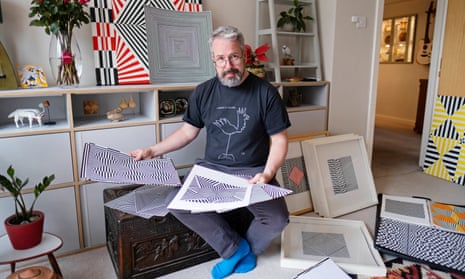For a short time last week, the entire works of artist George Westren were sat in a skip, heading for the rubbish dump. A few hours later, however, and they were going viral on social media, with people across the world marvelling at his technique and enquiring as to how they might buy some of the late artist’s work.
None of this would have been possible if it wasn’t for the actions of “nosy neighbour” Alan Warburton. Warburton had been left saddened during lockdown by the news that Westren, his shy upstairs neighbour of six years, had died alone in his flat. Last week, after hearing removal men emptying out the place, he was horrified to see hundreds of Westren’s drawings and paintings bagged up and headed for the tip.
“I couldn’t save it all,” he says from his Spitalfields flat, where Westren’s collected works currently reside. “The removal men were in a rush to get the job done. But I saw George’s portfolio lying in the skip and managed to get that. There were more than 150 drawings in there.”
And what drawings. Warburton is an artist himself, working in video and animation, and he couldn’t believe the quality of Westren’s pieces. They were almost all op-art drawings and paintings, geometric shapes heavily influenced by the British artist Bridget Riley. “Seeing the precision, knowing how difficult it is to do what he’s done, I was really impressed,” says Warbuton. “This was properly amazing, professional quality work. I can imagine him upstairs, working on it for weeks, it being his whole life.”

Even so, he didn’t expect the huge response that followed when he took to Twitter to post an image of his haul with the words: “Clearance company arrived this morning and were about to chuck hundreds of beautiful op-art drawings away”. Celebrities such as tennis star Martina Navratilova helped spread the story (“Amazing art … definitely must be saved!” she said), while others who knew Westren got in touch to help Warburton piece together the life story of the neighbour he barely knew. It soon became clear that Westren had had a troubled life, marked by periods of homelessness and alcoholism. Yet art had been his salvation. He appears to have first started drawing after a stint in rehab in 1999, and was believed to have added colour to his work after finally overcoming his addiction. “Some of the titles are so beautiful,” notes Warburton. “My favourite is called Star Of Hope.”
Westren was a genuine outsider artist – his chosen medium was felt-tip pen, presumably because it was affordable. But some of the compositions are intricate and adventurous, involving complex star designs and diagonals. Did Westren have a background in maths or engineering? Was, as some Twitter users have suggested, his proximity to the African fabrics on Petticoat Lane market an influence on his colour schemes? Warburton is still filling in many blanks.
Kim Noble, an artist and leader of the arts collective in Islington that Westren was a part of, says: “Art saved George’s life. When he was homeless he once took shelter from the rain in an art gallery and it happened to be a Bridget Riley exhibition. Something in those works inspired George to pick up a pen and try to replicate those images.”
Noble remembers his pupil as a softly spoken gentleman with a sharp sense of humour. “But he didn’t need or want teaching. He just wanted to draw these geometric patterns over and over again. He would attend the art group once a week for nearly 20 years until it was closed down, always with his art portfolio which he took everywhere – even if he often left it on the bus! He was so dedicated to that art collective and his art.”
In particular, Noble remembers a private view for his own work in London. “George came along and, although a quiet man, he proceeded to hold court with everyone, opening up his portfolio, showing anyone and everyone his drawings. People were really taken by him by the end of the evening – I think they forgot it was actually my work on display!” Both Noble and Warburton are confident that Westren would have loved for his artwork to have been shared and so widely admired.
Now Warburton hopes to do his neighbour justice by putting on a show of his work. He has already found a company to scan 30 of the best images and he plans to sell these prints to fund a small memorial show. He also hopes to find someone who can frame and preserve the works properly. “I don’t own the work, I’m only a temporary custodian,” he is keen to stress.
The experience has left him thinking deeply about life, legacies and loneliness. Before Westren died, Warburton knew him simply as the “sweet old man” upstairs. He would often see him coming and going and wonder what his life involved. “I thought maybe he was a journalist,” he says. Finding out that he was a fellow artist, and that the pair could possibly have been friends rather than just acquaintances who shared the occasional word, has led Warburton to think about the bigger picture.
“There are shy people in our communities: gentle, solitary people who probably won’t reach out for help even if they need it. And to think that I was so close and we had so much in common. So I think that’s why I see a kindred spirit in George, and I hope others can see that too.”
George Westren’s prints are available to buy.
